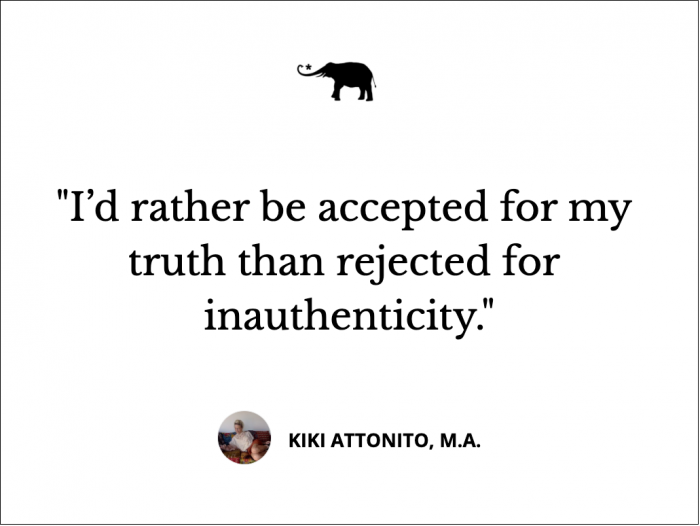View this post on Instagram
Hi, I’m Kiki, and I’m polyamorous.
It took me little time to go from being poly-baffled to poly-curious to polyamorous back in 2002 when the concept was introduced to me by a then-partner. Instead of feeling like this was a choice for me, I immediately was struck with the awareness that this was an identity that I had always held—much like being gay—and was coaxed to express when I was ready for it. Perhaps because I always harbor regret for having remained a closeted lesbian for several years, I felt it was time to take back the night and be my truth.
I came out as polyamorous to most people in my life soon after I began practicing, and I am still out loud and proud about this less conventional lifestyle to this day.
Over the past almost two decades, I have served as a member of the poly community and organizer, have led workshops on the topic to receptive audiences, have engaged in profound and inspiring conversations with many friends and family members, and have in my private practice as a psychotherapist counseled many poly clients through struggles and insights in a way that provides a unique relatability to them.
It’s my goal to be able to make information about this lifestyle accessible to all—not to “convert” anyone, as I truly believe that wiring for it may be highly based on a nature/nurture blend. But rather, to answer questions and provide clarification for which too many individuals seek answers!
Any questions? I joke—because questions are the number one response with which I, and my poly community members, are most often met. Questions keep us all learning, growing, understanding, feeling.
So, I invite you on a short but sweet journey through my “Polyamory FAQ” starter kit:
“Why do some call it polyamory and others just say an open relationship?”
In colloquial language, often, terms are used to describe a concept but don’t actually signify the same thing. Awareness of these terms allows us to cut through any misconceptions and to use proper verbiage to describe ourselves and others. An “open relationship” is predominantly used to describe a relationship in which the partners engage in sex outside the relationship but does not necessarily have implications beyond intimate relations. Polyamory, from the Greek words “many” and “love,” connotes that relations outside of the relationship(s) may involve romance, dating, the development of emotions, and the potential for bonding.
“I have heard the term ENM. What does this mean?”
ENM stands for ethical non-monogamy. This is a wonderful umbrella term, without being reductionist, for relationships in which outside involvement is mutually agreed upon and ideally supported. The term ethical implies that everything is kept above-board, amongst any and all individuals involved. This is a keystone of polyamory.
“So, are you a swinger?”
Not necessarily. The term swinging typically signifies that one or both or all partners, ideally ethically, of course, engage in sex with other people—and this usually takes place amongst both or all couples at the same time, in the same space. Swingers’ clubs are popularly frequented by singles and couples who want to engage in recreational sex with others and provide a great outlet for voyeurism for those to whom it appeals.
“I saw a show about a man who was polygamous. Is that the same thing?”
No. The suffix “gamy” implies “marriage,” and marriage to more than one person is legal in few places. Fortunately, for us polyamorists, love for more than one person is legal everywhere!
“What makes poly couples successful?”
The first “must” is honesty. When I say honesty, I mean no lies even by omission. Trust among partners is crucial for this lifestyle to be effective. Does this make it always easy? No. But does it lay an essential foundation for the partners to grow themselves and their relationship to incredible places? Absolutely. Honesty should be practiced in relationships regardless of status, but unfortunately, we hear much more about people who have cheated and are cheating, and mainstream media is teeming with shows and movies that involve deception.
It makes for a great plot, but I say keep that plot on the screen! I often joke to my wife, “If polyamory were more widely practiced, we might have no Lifetime Original Channel.”
The second “must” is communication. Much as with honesty, attempts at avoidance of discomfort through under-communicating will do the foundation of this relationship a great disservice. Life begins at the end of our comfort zones, and for us who engage in polyamory, clear expression of thoughts, feelings, “rules,” agreements, boundaries, and everything that the relationship comprises, will skyrocket us into an optimal existence. This is, after all, the end goal of most who desire a successful relationship.
“I don’t think I could ever be polyamorous!”
This one is a “frequently made statement,” but the implied question is, “Are you trying to sell this concept to me?” I am absolutely of the belief that—much like I describe poly not feeling like a “choice” to me—this is either for or not for someone, and that is a wonderful thing. Self-knowledge is gold, and if we were all the same, the world would be quite boring. I meet this comment with, “Then, definitely don’t be!” The listener is usually surprised at my nonchalance, but there is nothing to defend when we are 100 percent content with our lives as is.
“But don’t you get jealous?”
This question is the “where do you get your protein?” to veganism of the poly world. The answer is yes! I get jealous! Polyamorous individuals and couples experience jealousy. Jealousy is a healthy emotion signaling deep care for, and some understandable possessiveness, over some with whom we have bonded and grown intimately. It is what we do with jealousy that matters. I often hear the term jealousy differentiated from “envy,” wherein envy suggests a bitter, angry, or potentially revengeful spirit. It is much better to express jealousy to your partner(s) than to repress it; communication always wins.
“Is polyamory more common among individuals in the LGBTQIA community?”
I do not know the statistics, but my decades as a poly lesbian woman have brought me wonderful community and friendships with many polyamorous heterosexual individuals and couples. As noted above, though, I do think that I more readily and openly embraced and acted on my own polyamory because I had gone through coming out as a lesbian and realized that being myself with no apologies is true happiness for me. I’d rather be accepted for my truth than rejected for inauthenticity.
“What if your partner is excited about someone else?”
There is a beautiful term used in polyamory that I love extrapolating to many other concepts as well. Compersion refers to the joy produced by knowing of something, unrelated to oneself, that brings a loved one joy. Within polyamory, it connotes the vicarious joy associated with seeing one’s partner have a joyful relation with another. Not all poly partners have to reach a state of “joy” per se, but a common trait among successful poly couples is understanding and striving toward compersion. And yes, as above, this is not mutually exclusive from experiencing simultaneous jealously. Emotions are complicated but embracing and unraveling them is oh-so-beautiful.
“Do you have the right to approve or deny your partners’ partners?”
This is a topic that should be discussed at the advent of polyamory by couples, partners, or units, and it is important that all parties agree upon their decision with no double standards. Some decide to allow for veto power, which is the right of one party to “nix” another party’s involvement with some else. In this case, the involvement ceased. Some couples decide that veto power is not an option, as the concern that even subconscious jealousy or preconceived notions may influence the choice to request that an involvement discontinue. This is often case-specific, in which case, discussing at length why the veto is desired presents a great communication opportunity.
“What if one partner wants to date but doesn’t want the other to date?”
As long as all parties agree to this, then there is usually no problem. I have observed, though, that the non-dating party may change their mind and wish to date and/or engage in romance and sex, and I believe that it is important that no matter what the setup at the beginning of polyamory is, all remain flexible and enact no double standards.
“You must be very active since you always have so many options!”
Ha! It is important to remember that the freedom to do something is quite different from the choice to do it. Many polyamorous individuals, from solo poly (dating but not in a relationship) to in committed relationships to everything in between, choose not to engage in polyamory. A gay person is not gay because they are in a relationship; identity holds. It is a myth that polyamorous individuals are any more sex-driven, promiscuous, or “on the prowl” than your average human being going about life and love. It is also worth considering that relationships take more than one, and this would also be presuming that many other people are out there wishing to be involved with a polyamorous person or people. This is definitely not the case and discounts dual-party choice.
“When do you have the time?”
This is a tough one. Going into this requires recognition that it will require both physical and emotional time commitment. I have many poly friends who keep a shared Google calendar with their partner(s) and co-manage their engagements. I believe that when we feel passionately about something or someone, we create the time for ourselves to relish in it/them, which drives so many poly commitments. As with everything, honest and clear communication is paramount in order to ensure that everyone feels treated with kindness, fairness, respect, and dignity.
After synthesis of some Poly 101 concepts, I invite you to extrapolate and perhaps redefine what polyamory means for you. Insofar as poly means “many,” I’d like to highlight that we indeed do experience love outside our partnerships in so many more ways in life than those related to romance, dating, and sex.
When I was actively dating during my 30s, my wife elected not to date as she considered herself monogamous. My wife loves to travel to see her family in all corners of the United States, and her bonds and kinship with the amazing members of her extensive family is deep and profound to her. She shared with me that this represented to her what I described feeling with those with whom I formed connections, as it was and still is something outside of one another that brings us joy but also represents “love for another” that occurs in addition to the love we feel for one another. A great exercise for partners could be discussing how they “do poly with life.” I suspect that the term compersion will be relevant here.
At the end of the day, polyamory cannot be described or defined by anyone or even several “examples” from friends or social media. This lifestyle is unique to everyone and every bond, so we should make no assumptions.
All relationships are created differently; but the keyword is created, by all parties involved, as they enter into an unwritten contract with guidelines to which all can adhere with faith, honesty, and truth to self.












Read 2 comments and reply